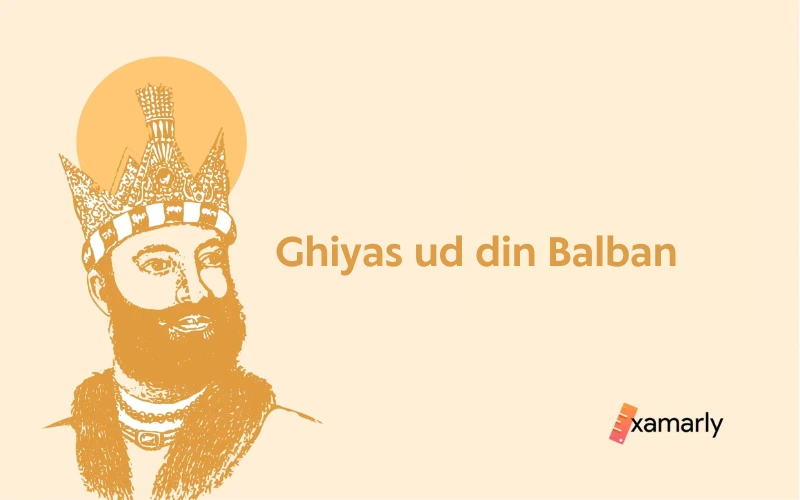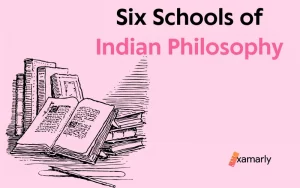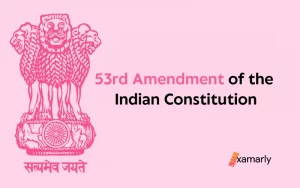Numerous influential leaders had long been interested in the Delhi Sultanate.
Sultan Ghiyas ud din Balban was one of the most renowned kings in the history of the Delhi Sultanate, who uplifted the throne. He was the ninth Sultan of the Slave Dynasty and was appointed as the regent of the last Shamsi Sultan, Nasiruddin Mahmud.
He diminished the influence of the nobility and increased the sultan’s prominence. He is remembered for his accomplishments and military campaigns.
In this article to aid your UPSC preparation, you’ll learn about his early life, his ascension to the throne, the re-organization of the army, the famous battles, and several other significant incidents of his life.
Let’s examine and learn about Sultan Ghiyas Ud Din Balban’s past in more detail through this article.
Ghiyas Ud Din Balban: Background
Ghiyasuddin Balban, the ninth ruler of the Mamluk dynasty (also known as the Slave dynasty), was the greatest sultan in the history of the Delhi Sultanate. His real name was Baha Ud Din (13th century).
He was a maverick, ruthless, and determined ruler who served the city of Delhi. Balban served as the regent of Nasiruddin Mahmud. He was the final Shamsi Sultan.
However, what made him such a remarkable man? Read on to find out more about him.
Ghiyasuddin Balban was an Ilbari Turk. He was a mighty Sultan of Delhi who served from 1266 to 1287 CE. His name sounds a lot like Ghiyath ud-din Tughluq, who ruled the city only a few years before Ghiyas Ud din Balban.
In addition to being a great ruler, he also became a Turkic slave of the Iltutmish and was later released from his bonds. After this, Ghiyas Ud din Balban was educated and made the head of the Chalisa. He also provided facilities to the learned men from Central Asia.
Balban, with an iron fist, reformed the military, and civil lines to earn stability and prosperity in government, even though he had rare military accomplishments. This resulted in granting him the position, beside Sultan Shams-ud-din Iltutmish and Alauddin Khilji, one of the most powerful rulers.
During his reign, Sultan Ghiyas Ud din Balban had to contend with an all-powerful military oligarchy. These people were known as “the Forty” and were the leaders of the sultanate. The rulers of the sultanate had been ruled by this elite group since the death of the Iltutmish.
Balban was one of these men who sought to overthrow the Chihilgan and restore the prestige of the crown.
His main foe was Imaduddin Raihan, who is identified as a Hindu Murtad (one who rejects Islam) in literature produced after Balban’s time. Some others claim that Raihan is also of Turkic descent.
Early life
Ghiyas ud din Balban, one of the most remarkable rulers, was born to a Central Asian Turkic noble origin and in his childhood, he was seized as a slave.
Later, Khwaja Jamal ud din Basri bought him from the Mongols. He was further sold by Khwaja to Sultan Shamsuddin Iltutmish when brought to Delhi.
Initially, he was given the task of a water carrier, and later as the Khasdar, or the personal attendant of the king. Further, he managed to be the most notable of the forty Turkic-origin nobles or the Chalisa.
He was rewarded with military and political responsibilities. He became the Amir-i-Shikar or hunting lord, during Raziya Sultana‘s rule. He made rapid strides in the reigns that followed her ouster, eventually rising to the position of Jagir (lord) of Hansi under the reign of Bahram Shah.
Balban was Ala ud din Masud’s vizier from 1246 until 1265. Nasiruddin Mahmud replaced him as Sultan after Masud Shah’s overthrow. Mahmud wed a Balban’s daughter.
Additionally, Balban appointed his younger brother Kishlu Khan as Lord Chamberlain (Amir-i Hajib). While his cousin Sher Khan is Jagir of Lahore and Bhatinda.
Related Reading: Muiz Ud Din Bahram: Sultan of the Slave Dynasty
Ascension to the throne
Balban was rewarded with the title of Ulugh Khan by Sultan Nasir-ud-din Mahmud Shah. He was also felicitated with the tag of Naib-i-mamlikat or Deputy Sultan. This was obviously because Nasir-ud-din was ineffective and inept and was counting more on him for the surveillance of state affairs.
Hence, the actual power slowly passed to Balban’s court. His influence spread over time and put down several internal rebellions. He checked the external aggressions, especially of Mongols.
Nasir-ud-din, the Sultan, regarded him as a crucial person. In the absence of a legitimate heir to the throne, he chose Balban as his successor.
The news of the death of Nasir-ud-din Mahmud came in 1266. This led to Balban’s succession to the throne.
Reign of Ghiyas Ud Din Balban
Now that you have an idea about who this was and his background, let us dive into the details of his reign and explore. the achievements of Ghiyasud Din Balban.
Re-organization of army
- Balban’s army was majorly comprised of Turkish origins. The army was disorganized and lacking in manpower, and the threat of a Mongol invasion was on the horizon. With this in mind, Ghiyas ud Din Balban decided to re-organize the army and military lines, to ensure it would defend the country.
- He appointed Imad-ul-Millk as Minister of War to be the army’s Diwan-i-Ariz (Minister of War). Balban was very particular about the training of his soldiers, and he supervised their training.
- The Wazir relinquished control of the minister in charge of the army’s finances. Additionally, the Sultan had complete faith in him.
- The Army’s efficiency and military training were exponentially improving. Therefore, Balban repressed internal revolts and exterior aggressions with the support of a large and powerful army.
Also Read: Shamsuddin Kayumars – 11th & Last Ruler of the Slave Dynasty
Clearance of Mewatis
- After the evening Namaz, there was a check to ensure the closure of the city’s western gates because of the Mewatis’ terrible control of Delhi’s outskirts.
- According to legend, Balban slew the apostate Mewatis and gave the order to cleanse the trees.
- The death toll reached 100,000 after the ruthless killing of people and clearance of the jungles.
- He dealt with the bandits in the Doab area with an Iron Hand.
Battle with Bengal
- The Bengali kings caused the Delhi administration a lot of trouble.
- The local authorities declared their independence. This happened while Delhi was in a state of anarchy.
- The Bengal subedar Tughril Khan disregarded the aged Sultan of Delhi. And he proclaimed his independence in 1279.
- An angry Sultan sent out a sizable force, but Tughril Khan wiped them out. Balban sent out a second army, but it was met with the same response.
- Balban then sent a bigger force to Bengal. Tughril Khan learned of Balban’s march into Bengal and immediately left the city, seeking safety in the forests.
- He was captured, subjected to torture, and killed.
- All the followers of Tughril Khan were executed at his location after a large-scale massacre was ordered.
- After the rebellion was put down, Sultan went back to Delhi. Later, Bengal’s affairs were given to Balban’s second son, Bugara Khan.
Check Out Our Blog On: Aram Shah: Second Sultan of the Slave Dynasty
Mongol invasions
- During the Mongol Invasions, the first Sultan of Delhi, Ghiyas Ud Din Balban, took effective steps to stem the invasions. He was vigilant about the Mongols’ plans and did not leave the capital, Delhi.
- Balban made all possible efforts to protect the western frontiers as Lahore was then within Mongol’s hold on the western frontiers and continuous risk of invasion hung on Sind and Multan. Besides all the efforts the Mongols continued plundering raids without concern.
- Sultan Balban protected the borders with a line of forts with guards. The frontiers were preserved by the Amirs assigned by Balban, but they proved to be incapable of stopping the Mongols.
- Later Balban divided the territory into two and allotted each side to each of his sons, Prince Muhammad Khan and Bugara Khan.
- Balban won this war after continuous efforts, but unfortunately, he lost his son Prince Muhammad Khan during this war.
- Mongols were defeated away as Balban’s cavalry horses were perfectly adaptable to the Indian climate. The military reign also added to the strength.
Additional information
- Balban was the first king to assume this role, and he was fully aware of the requirements and obligations that go along with it. He is regarded as one of India’s cruellest kings. Any disobedience to the Sultan’s commands was met with severe punishment.
- He introduced to India the Iranian method of Sijda/Zaminbosi as well as Paibosi.
- He also introduced rigorous court discipline. For instance, to greet Sultan Sijda / Zaminbos, it had to be done in a specific manner. One would kiss Sultan Paibosi’s feet and bow to the ground.
- He promoted the Iranian Theory of Divine Rights. According to this theory, it is believed that the Sultan is a representation of God on earth.
- He shattered the influence of the “Corp of Forty.”
- The fearsome slave band known as the “Chihalagani,” had been vanquished by Balban. They were the actual heirs of Iltutmish.
- He gathered his army to confront the Mongols.
- He assigned secret reporters and news writers to each department, province, and district. In this way, he would gather information on the state’s varied activities. If they did not perform their tasks, they were severely punished.
- A Badaun news reporter was hung over the city gate as a punishment. He had failed to promptly report Malik Baqbaq’s crime. Amir Khan, the governor of Awadh, was also hanged outside the city’s gate. The reason for doing so was his failure to control the revolt in Bengal.
Death
The gloom of losing his favourite son, Prince Muhammad, languished Balban’s health. After becoming aware of his failing health, Balban named Kai Khusrav as his successor. Kai Khusrav was Prince Muhammad’s eldest son.
Ghiyas Ud Din Balban passed away in 1287.
Upon Balban’s death, the throne was succeeded by his grandson Qaiqabad. Muiz-ud-din Qaiqabad, Bughra Khan’s son was declared the heir to the throne.
The tomb of Balban was constructed with a true arch as well as a dome, for the very first time in India. Towards the east of his tomb is a grave of Khan Shahid in a rectangular area. The tomb is in Mehrauli Archaeological Park in the city of Delhi.
You Might Also Like: Ruknuddin Firuz: Sultan of the Slave Dynasty
Conclusion
Through this blog for UPSC preparation, you learnt that the ninth sultan of the Mamluk dynasty in Delhi, Sultan Ghiyas Ud Din Balbin, was a renowned military leader and diplomat who had made several conquests while serving as vizier.
Ghiyas Ud Din Balban is remembered as one of the most courageous rulers of his time. He pulled the reign with utmost perseverance and chivalry, as he defeated the rebels and faced the troubles.
It was Balban’s prowess that tossed the danger of Mongol raids. In addition, he was effective in establishing law and order in the nation. He did so by setting up an efficient espionage system.
Balban initiated Navroz, the celebrated Persian festival. The tales of his valour are marked in the history of the Delhi Sultanate in golden words.
Ishwari Prasad describes the greatness of Balban’s rule and statesmanship, in one of her verses. He was one of the most powerful Sultans in the Delhi Sultanate.
FAQs related to Ghiyas Ud Din Balban
Why did Sultan Ghiyas Ud Din Balban not choose Bughra Khan as his successor?
Prince Muhammad Khan, the elder son of Balban, was to have become his heir. On March 9, 1285, he was killed fighting the Mongols.
Nasiruddin Bughra Khan, his other son, preferred to hold onto his position as king of Bengal rather than ascend to the throne. As a result, Balban designated his grandson Kai Khusrav, son of Prince Muhammad, as his apparent heir.
Who succeeded Balban to rule the sultanate?
Balban centered his aspirations for his succession on his eldest son Prince Muhammad, who passed away before him. His second son, Bughra Khan denied the throne. In a fit of rage, Balban appointed Kai Khusrav as his heir apparent.
Kai Khusrav was Balban’s murdered son’s son. When Balban passed away in 1287, his nobles proposed Qaiqabad for the position of Sultan. Thus, Qaiqabad ruled the Delhi Sultanate after the demise of Ghiyas Ud Din Balban.
Whose tomb featured the first true arch in the sultanate memorial?
The mausoleum of Sultan Balban or the tomb of Balban, which was constructed between 1287 and 1288, has the earliest authentic Islamic arch.
How long did Ghiyas Ud Din reign’s last?
1266 – 1287 CE
Who was Balban’s master?
Iltutmish






